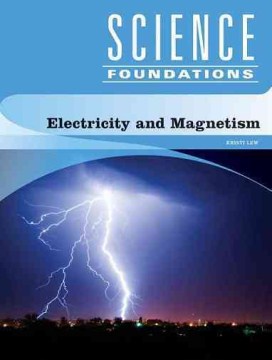

An introduction to the basic scientific concepts of electricity, magnetism, and electromagnetism, explaining how electric circuits and currents work, and describing the technological achievements made possible by electric motors and generators.

Covers the Physics content specified in the NSW Physics syllabus. Sample data has been included for suggested experiments to give you practice to reinforce practical work in class. Each book in the series contains a summary, with occasional more detailed sections, of all the mandatory parts of the syllabus, along with questions and answers.

Improve your knowledge and exam skills using the exam style questions and answers covering every aspect of the syllabus.
Clear definitions and images aim to strip away the complexities of difficult science concepts. A helpful glossary, comprehensive index and tables, charts and diagrams are also included. It covers topics such as electricity and magnetism, atomic and nuclear power, reflection and refraction.
Stumped trying to make sense of Physics? This book will help you grasp the essential concepts with ease.
This is a lively, informative guide that shows what physics is, how it works and why it is vital to everyday life. Written in a conversational style, this book offers children an approachable source of information on key subjects such as gravity, magnetism, thermodynamics and the solar system. Illustrated with humorous drawings, cartoons and diagrams by Adam Larkum, complicated topics are kept fun with a variety of techniques including comic strips and fact boxes. Simple experiments give children working examples to learn from.
Ampère’s law, one of the basic relations between electricity and magnetism, stating quantitatively the relation of a magnetic field to the electric current or changing electric field that produces it. The law is named in honour of André-Marie Ampère, who by 1825 had laid the foundation of electromagnetic theory. An alternative expression of the Biot-Savart law (q.v.), which also relates the magnetic field and the current that produces it, Ampère’s law is generally stated formally in the language of calculus: the line integral of the magnetic field around an arbitrarily chosen path is proportional to the net electric current enclosed by the path. James Clerk Maxwell is responsible for this mathematical formulation and for the extension of the law to include magnetic fields that arise without electric current, as between the plates of a capacitor, or condenser, in which the electric field changes with the periodic charging and discharging of the plates but in which no passage of electric charge occurs. Maxwell also showed that even in empty space a varying electric field is accompanied by a changing magnetic field. In this more general form, the so-called Ampère-Maxwell law is one of the four Maxwell equations that define electromagnetism.

Electromagnetism, science of charge and of the forces and fields associated with charge. Electricity and magnetism are two aspects of electromagnetism.
Electricity and magnetism were long thought to be separate forces. It was not until the 19th century that they were finally treated as interrelated phenomena. In 1905 Albert Einstein’s special theory of relativity established beyond a doubt that both are aspects of one common phenomenon. At a practical level, however, electric and magnetic forces behave quite differently and are described by different equations. Electric forces are produced by electric charges either at rest or in motion. Magnetic forces, on the other hand, are produced only by moving charges and act solely on charges in motion.
Electric phenomena occur even in neutral matter because the forces act on the individual charged constituents. The electric force in particular is responsible for most of the physical and chemical properties of atoms and molecules. It is enormously strong compared with gravity. For example, the absence of only one electron out of every billion molecules in two 70-kilogram (154-pound) persons standing two metres (two yards) apart would repel them with a 30,000-ton force. On a more familiar scale, electric phenomena are responsible for the lightning and thunder accompanying certain storms.
References
Encyclopædia Britannica. (n.d.). Ampère’s law. Britannica School. Retrieved April 15, 2024, from https://school.eb.com.au/levels/middle/article/Amp%C3%A8res-law/7236
Encyclopædia Britannica. (n.d.). Electromagnetism. Britannica School. Retrieved April 15, 2024, from https://school.eb.com.au/levels/middle/article/electromagnetism/106021